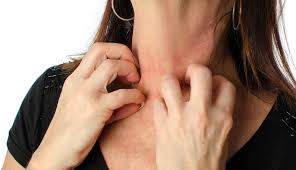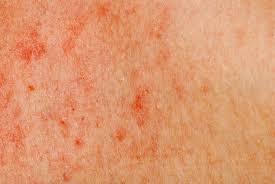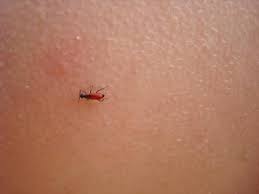 If you wake up one morning with a red rash on your body it can be a bit scary. Some skin rashes are not itchy and others may burn or sting. Some have no sensation but are just inflammations. Think about if there is something contagious that others have or that may be passed around in your child’s school. Often a child will be able to tell you if some kids are out and if there is chicken pox or an outbreak in the school. Notes are not always sent home about these matters unfortunately.
If you wake up one morning with a red rash on your body it can be a bit scary. Some skin rashes are not itchy and others may burn or sting. Some have no sensation but are just inflammations. Think about if there is something contagious that others have or that may be passed around in your child’s school. Often a child will be able to tell you if some kids are out and if there is chicken pox or an outbreak in the school. Notes are not always sent home about these matters unfortunately.
What’s This Rash
One rash that is highly contagious is the scabies rash. This is caused by a mite that is invisible which lays eggs inside the skin. The rash is actually an allergic reaction. It can spread quickly through nursing homes, classrooms and families through direct skin contact. Kids are often wrestling , passing toys to each other and interacting physically. A cream is put on the body overnight and it is advised that all family members as well as classmates (if the patient is a student) apply this as well so that the mites don’t hop back and forth causing re-infestations.
Other rashes that are common include eczema, hives, allergic reactions and stress rashes. Heat rashes are also common in the summer time. Rashes can look very much like each other and it is important to see a doctor or dermatologist for an accurate diagnosis. For instance, if you have eczema but aren’t diagnosed properly you may not be using moisturizer twice a day which is important for your skin to heal. On the other hand, if you have a fungus, you may want to avoid certain moisturizers that can increase the rash. Some rashes are improved by sunlight and others made worse. For a heat rash you don’t want to spend time in the sun and increase perspiration.
How to Treat Itchy Skin Rashes
The term “rash” is often generically used to describe various conditions that affect the skin. Because itchy skin rash is not a specific diagnosis and is not particularly deleterious to one’s health (except for making one’s life miserable), there are a number of treatments on the market that bring about relief for itchy skin.
Itchy skin rashes can be attributed to hereditary factors; as reactions to irritants ( allergic or non-allergic); as consequence of a bacterial/fungal infection, or other explainable reasons. Most will go away on their own or within a short period of time, from a few days to a week. However, if the rash persists or becomes more widespread, one should see a doctor for underlying causes and treatment.
Eczema:
 Eczema is the big category of itchy skin rashes that includes atopic dermatitis, contact dermatitis, psoriasis (hereditary), pityriasis rosea, and xerosis. Eczema is not related to allergic reactions, so changing one’s diet or surrounding environment does not help. However, by minimizing discomfort and irritation from the itch, there are several over-the-counter treatments or prescription creams to alleviate the itch.
Eczema is the big category of itchy skin rashes that includes atopic dermatitis, contact dermatitis, psoriasis (hereditary), pityriasis rosea, and xerosis. Eczema is not related to allergic reactions, so changing one’s diet or surrounding environment does not help. However, by minimizing discomfort and irritation from the itch, there are several over-the-counter treatments or prescription creams to alleviate the itch.
OTC ( over-the-counter) anti-itch creams are available that use camphor, menthol, or brand names like Itch-X or Benadryl for the treatment of eczema. Alternatively, two herbal remedies, St. John’s Wort and Wild Pansy, both derived from European flowers help soothe and relieve itchy skin such as eczema. St. John’s Wort has astringent qualities that moisten and refresh skin, while Wild Pansy also helps address acne problems.
Atopic Dermatitis:
This hereditary skin problem is a common form of eczema that usually appears in early childhood, with symptoms of chapped cheeks, or scaly patches which show on the scalp, torso, arms and legs. Later on in childhood, atopic dermatitis can spread to the elbows and knees. In adulthood, it often shows up on eyelids, hands, genitals, or all over the body.
The word atopic refers to allergens or conditions that run in families, such as asthma or hay fever, while dermatitis means inflammation of the skin. Although people with atopic dermatitis may have allergies, the condition itself is not due to allergic reaction. As such, symptoms of itchiness and inflammation can come and go, but can worsen during winter months when skin can become quite red, cracked or swollen.
Atopic dermatitis can be treated with OTC creams such as hydrocortisone; .5%-1% concentration is best used for children and for sensitive areas on the face or groin. Thicker areas can be addressed with more potent creams like Lidex or Temovate. Non-steroidal preparations are available but are not considered as effective. ( Protopic, Elidel). However, a mixture of Burrow’s Solution with tap water can help dry up atopic dermatitis in its oozy stages.
Contact Dermatitis:
This kind of eczema is a result of direct contact with an allergen or something that irritates the skin. It differs from atopic dermatitis in that it tends to be more localized as opposed to widespread. An allergen can be poison oak or ivy, a reaction to nickel found in jewelry, watches, earrings, or cell phones.
General treatment for contact dermatitis is to avoid the allergen or minimize exposure to irritants such as frequently washing hands, use of caustic solvents, or continuously licking one’s lips because they are chapped or dry. Refer above to atopic dermatitis for similar treatments.
Jewelweed is an herb which provides relief to those suffering from poison ivy or oak, bee stings or insect bites. By crushing the leaves into a ball and rubbing the ball quickly over the skin will bring relief to an itchy rash.
Other Scaly Itchy Rashes:
Psoriasis is a hereditary skin rash that usually shows up on elbows, knees, and elsewhere. Herbal remedies such as Witch Hazel is a natural astringent with anti-oxidant properties great for treating psoriasis and sunburn. Soak an ounce of Witch Hazel bark in a pint of hot water for ten minutes, strain it, allow to cool, and then apply with a clean cloth for about 30 minutes.
Chamomile essential oil, with its anti-inflammatory and anti-microbial properties, serves to soothe and relieve itchy rash due to psoriasis and eczema. However, if one is sensitive to grass or ragweed, one may have an allergic reaction to this oil.
Fungal or Bacterial Infections:
Contrary to popular belief, itchy skin rashes are rarely due to bacterial or fungal infections. These types of skin rashes are not particularly contagious; are not caused by unhygienic situations, nor contracted from animals. However, the infection does affect the skin under the breasts or groin, appearing as red parts with pustules around the edges.
Non-prescription anti-fungal creams are available that include Lotrimin, Mycelex, or Lamosil. Prescription drugs are Econazole or Nizoral. Should these creams not prove successful, it is probably not a fungal infection to begin with, but a form of eczema.
Bacterial infections are usually caused by staph or strep germs ( Impetigo), commonly seen in children but not related to poor hygiene. Non-prescription anti-bacterial cream Neosporin is usually not effective for this kind of rash, whereas oral antibiotics such as Bactroben are quite effective.
Alternatively, aloe vera is an anti-itch, anti-inflammatory, anti-bacterial/fungal plant that contains folic acid, zinc, Vitamin C and E for a plethora of healthful benefits. To relieve itch, slice a piece of leaf from the plant and apply directly to the affected area.
Calendula essential oil is also an anti-inflammatory remedy that is great for treating diaper rash and stimulating white blood cells to attack harmful bacteria. Mix 2 tsp. of calendula into a cup of boiling water, let simmer for 10 minutes, cool, and apply to skin with a clean cloth.
Scabies:
 This is a rash caused by a mite that burrows under the skin, with resulting redness and bumpy skin generally found on the wrist, between the fingers, or on the waist. A lotion is normally used to kill the mite, and this condition usually lasts a month.
This is a rash caused by a mite that burrows under the skin, with resulting redness and bumpy skin generally found on the wrist, between the fingers, or on the waist. A lotion is normally used to kill the mite, and this condition usually lasts a month.
Widespread Rashes:
Rashes that appear all over the body may be caused by a virus ( excluding herpes or shingles) or a reaction to medication. An allergic drug rash that appears after having taken certain medication for 2-3 weeks, will normally go away within a week, after the drug is discontinued.
Other rashes include hives (uticaria) which exhibit itchy red welts appearing and disappearing on various parts of the body, but are not attributed to an allergen. As well, a heat rash can surface on the skin as an irritation from excessive sweating during hot and muggy weather, seen most commonly in children. A heat rash looks like a cluster of small blisters or pimples that form mostly on the neck, under breasts, elbows, groin, and upper chest.
One note of caution, people with atopic dermatitis/eczema should not be vaccinated against smallpox, whether the condition is active or not. People with atopic dermatitis or eczema are more susceptible to having the virus spread on the skin, which can lead to a more serious problem called eczema vaccinatum.

